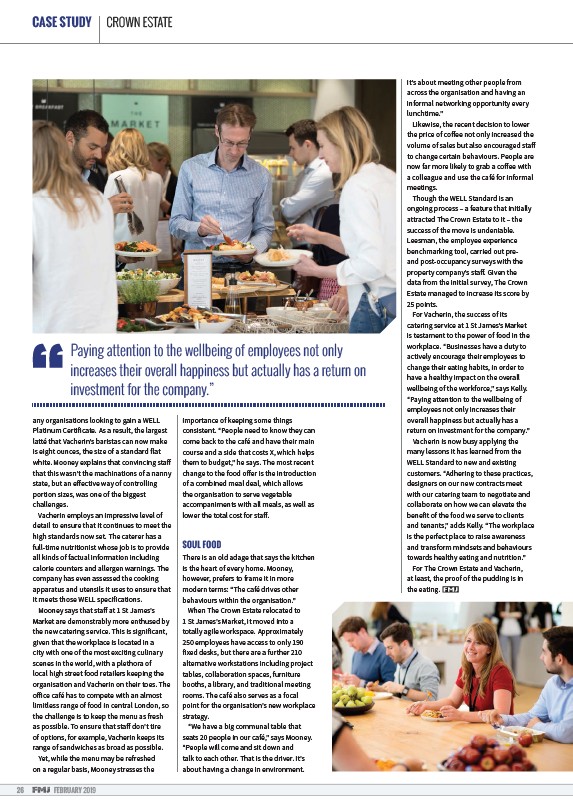
CASE STUDY CROWN ESTATE
Paying attention to the wellbeing of employees not only
increases their overall happiness but actually has a return on
investment for the company.ƌ
26 FEBRUARY 2019
It’s about meeting other people from
across the organisation and having an
informal networking opportunity every
lunchtime.”
Likewise, the recent decision to lower
the price of co ee not only increased the
volume of sales but also encouraged sta
to change certain behaviours. People are
now far more likely to grab a co ee with
a colleague and use the café for informal
meetings.
Though the WELL Standard is an
ongoing process – a feature that initially
attracted The Crown Estate to it – the
success of the move is undeniable.
Leesman, the employee experience
benchmarking tool, carried out pre-
and post-occupancy surveys with the
property company’s sta . Given the
data from the initial survey, The Crown
Estate managed to increase its score by
25 points.
For Vacherin, the success of its
catering service at 1 St James’s Market
is testament to the power of food in the
workplace. “Businesses have a duty to
actively encourage their employees to
change their eating habits, in order to
have a healthy impact on the overall
wellbeing of the workforce,” says Kelly.
“Paying attention to the wellbeing of
employees not only increases their
overall happiness but actually has a
return on investment for the company.”
Vacherin is now busy applying the
many lessons it has learned from the
WELL Standard to new and existing
customers. “Adhering to these practices,
designers on our new contracts meet
with our catering team to negotiate and
collaborate on how we can elevate the
benefit of the food we serve to clients
and tenants,” adds Kelly. “The workplace
is the perfect place to raise awareness
and transform mindsets and behaviours
towards healthy eating and nutrition.”
For The Crown Estate and Vacherin,
at least, the proof of the pudding is in
the eating.
any organisations looking to gain a WELL
Platinum Certificate. As a result, the largest
latté that Vacherin’s baristas can now make
is eight ounces, the size of a standard flat
white. Mooney explains that convincing sta
that this wasn’t the machinations of a nanny
state, but an e ective way of controlling
portion sizes, was one of the biggest
challenges.
Vacherin employs an impressive level of
detail to ensure that it continues to meet the
high standards now set. The caterer has a
full-time nutritionist whose job is to provide
all kinds of factual information including
calorie counters and allergen warnings. The
company has even assessed the cooking
apparatus and utensils it uses to ensure that
it meets those WELL specifications.
Mooney says that sta at 1 St James’s
Market are demonstrably more enthused by
the new catering service. This is significant,
given that the workplace is located in a
city with one of the most exciting culinary
scenes in the world, with a plethora of
local high street food retailers keeping the
organisation and Vacherin on their toes. The
o ice café has to compete with an almost
limitless range of food in central London, so
the challenge is to keep the menu as fresh
as possible. To ensure that sta don’t tire
of options, for example, Vacherin keeps its
range of sandwiches as broad as possible.
Yet, while the menu may be refreshed
on a regular basis, Mooney stresses the
importance of keeping some things
consistent. “People need to know they can
come back to the café and have their main
course and a side that costs X, which helps
them to budget,” he says. The most recent
change to the food o er is the introduction
of a combined meal deal, which allows
the organisation to serve vegetable
accompaniments with all meals, as well as
lower the total cost for sta .
SOUL FOOD
There is an old adage that says the kitchen
is the heart of every home. Mooney,
however, prefers to frame it in more
modern terms: “The café drives other
behaviours within the organisation.”
When The Crown Estate relocated to
1 St James’s Market, it moved into a
totally agile workspace. Approximately
250 employees have access to only 190
fixed desks, but there are a further 210
alternative workstations including project
tables, collaboration spaces, furniture
booths, a library, and traditional meeting
rooms. The café also serves as a focal
point for the organisation’s new workplace
strategy.
“We have a big communal table that
seats 20 people in our café,” says Mooney.
“People will come and sit down and
talk to each other. That is the driver. It’s
about having a change in environment.